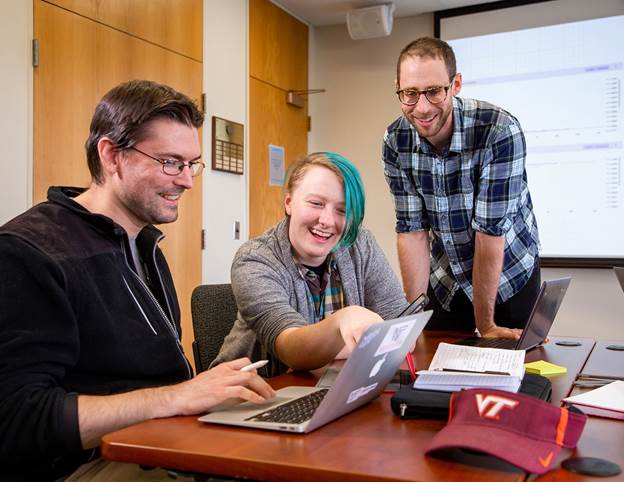
University Libraries’ data consultant Chreston Miller and Department of Food Science and Technology researchers Jacob Lahne and Leah Hamilton discuss whiskey research data. Photo by Trevor Finney for Virginia Tech.
How can a whiskey reviewer in a magazine describe the flavor of whiskey so a reader can not only understand it but get can some idea of what the taste is really like and whether he should spend money for it? Smoke? Coal dust? Fine leather? Dark berry fruit? Coffee grounds?
The problem is that so many descriptors and personal perceptions swirl around a glass of whiskey. Published whiskey reviews include sensory and nonsensory descriptions of thousands of these distilled spirits.
Finding meaning in and understanding these descriptors is at the heart of discriminating whiskey connoisseurs’ debates. But even for the not-so-discriminating, all of these words can be confusing for investigating the flavor and value of a bourbon that costs $130 a bottle when a $55 substitute would do.
A research project by Department of Food Science and Technology researchers Jacob Lahne and Leah Hamilton and University Libraries’ data consultants Chreston Miller and Michael Stamper has received a grant to create a tool that finds a common language to describe the flavor of whiskeys. How complicated is that? They are combing through a data set of 6,500 published whiskey reviews of about 50 to 100 words each.
The grant the Virginia Tech researchers received is awarded to projects that bring together scientists, engineers, artists, and designers to tackle some of the world’s most complex challenges. Figuring out how to consistently and systematically describe whiskey could be an important and complex challenge for many, but beyond this specific food product, the deep learning tool this project creates could be used for all research that uses descriptive data.
It’s much more complicated than it might sound. The team is applying Natural Language Processing (NLP), a subfield of linguistics, computer science, information engineering, and artificial intelligence that involves programming computers to process and analyze large amounts of natural language data — whiskey descriptors. According to the project team, there have been no previous attempts to apply this sort of NLP approach for sensory-evaluation purposes.
“We don’t know anyone else who has tried to take these reviews, which are in descriptive but messy natural language, and systematically analyze them this way. One of the nice things about whiskey is its enthusiast market,” said Lahne. “People care about taste deeply. Whiskey lives or dies by sensory perception. These reviews are in metaphorical, messy, natural language. What we’re trying to get to is some shared concept about taste.”
Hamilton said they may even be able to make connections among the descriptors used, the production process, and the geographical origin of the liquor.
“This tool will analyze free-response comments and identify which words are describing flavor and separate them from what’s not descriptive,” said Hamilton. “It will also identify which words are related and describe the same flavor. This will ultimately be helpful to consumers who may want to buy something that’s close to a high-dollar whiskey but is more affordable.”
When the team has its common language defined, they will pass the data to Stamper, an information visualization and interaction designer, to create the user stories, flows, and interfaces that audiences will use to interact with, and draw insight and meaning from.
Upon the completion of the year-long process, the team will raise a glass to future research that could build upon this novel approach they have begun.
“At some point, we may get to a place where we describe flavors like we do colors; it would be standardized,” said Hamilton. “This is a great step in that direction.”



